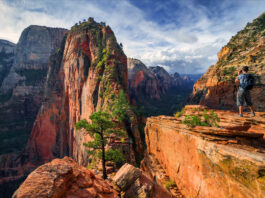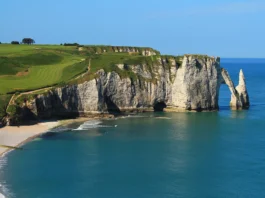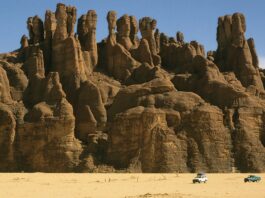The Benagil Sea Cave, located on the southern coast of Portugal, is a mesmerizing natural wonder that captivates visitors from around the world. Nestled within the stunning Algarve region, this sea cave stands as a testament to the immense power and beauty of coastal geological processes. Its popularity as a tourist attraction is fueled by the cave’s unique features, such as its striking rock formations, captivating lighting, and its accessibility both by sea and by land.
Situated near the village of Benagil, the sea cave has gained global recognition for its breathtaking beauty and has become an iconic symbol of the Algarve. It is one of several magnificent sea caves that dot the picturesque coastline, but the Benagil Sea Cave stands out due to its large opening and the intricate play of light and shadow that creates a magical atmosphere inside.
Over the years, the cave has captured the imagination of explorers, photographers, and nature enthusiasts alike. Its natural beauty has been featured in numerous travel magazines and social media platforms, making it a must-visit destination for those seeking to witness the wonders of nature firsthand.
In this exploration of the Benagil Sea Cave, we will delve into its geological origins, the forces that shaped it, and the unique features that make it a geological masterpiece. We will also explore its ecological significance, cultural and historical aspects, as well as the challenges and opportunities it faces as a popular tourist destination. So, let us embark on a journey to uncover the secrets and marvels of the Benagil Sea Cave.

Contents
Formation of the Benagil Sea Cave
The formation of the Benagil Sea Cave is a fascinating result of millions of years of geological processes and the relentless power of coastal erosion. The Algarve region, where the cave is located, is characterized by a limestone-dominated coastline, which played a crucial role in the cave’s formation.
- Limestone Geology: The underlying geology of the Benagil Sea Cave is primarily composed of limestone. Limestone is a sedimentary rock formed from the accumulation of marine organisms such as coral, shells, and microorganisms over long periods of time. The Algarve region was once covered by a shallow sea, and the remains of these marine organisms gradually compacted and solidified to form the limestone rock layers.
- Coastal Erosion: The formation of sea caves, including the Benagil Sea Cave, is primarily attributed to the erosive forces of waves, currents, and tides. As waves crash against the coastline, they exert pressure on the rocks, gradually eroding them over time. The power of the waves is amplified during storms and high tides, further accelerating the erosion process.
- Differential Erosion: Coastal erosion is not uniform, and certain areas of the coastline are more susceptible to erosion than others. In the case of the Benagil Sea Cave, the limestone cliffs along the coast experienced differential erosion, where softer and weaker rock layers were eroded at a faster rate compared to the more resistant layers. This differential erosion created openings and cavities in the cliffs, eventually forming the cave.
- Hydraulic Action and Abrasion: Two primary processes contribute to the erosion of the rocks and the formation of the sea cave. Hydraulic action involves the force of water crashing against the rock, causing it to weaken and disintegrate. Abrasion occurs when waves carry sediment, such as sand and pebbles, which act as natural tools that wear away the rock surface over time.
- Cave Development: As erosion progresses, a small opening or fissure is created in the coastal cliff. Over time, the continuous pounding of waves widens and deepens the opening, gradually forming a sea cave. In the case of the Benagil Sea Cave, its large opening was likely a result of extensive erosion and the presence of a weak point in the limestone layers.
The formation of the Benagil Sea Cave is an ongoing process, with the constant action of waves continuing to shape and modify its features. Its unique geological origins, combined with the enchanting coastal environment, make the Benagil Sea Cave a truly remarkable natural masterpiece.

Geology of the Benagil Sea Cave
The Benagil Sea Cave is a geological marvel located along the southern coast of Portugal in the Algarve region. Understanding the geology of the cave helps us appreciate its unique features and how it was shaped over time. Here are key aspects of the geology of the Benagil Sea Cave:
- Limestone Formation: The Benagil Sea Cave is primarily formed within limestone rock. Limestone is a sedimentary rock composed mainly of calcium carbonate, which accumulates over millions of years from the remains of marine organisms such as coral, shells, and microorganisms. The Algarve region’s geological history includes periods when the area was covered by ancient seas, leading to the deposition of thick limestone layers.
- Karst Topography: The Algarve region, including the area surrounding the Benagil Sea Cave, is characterized by karst topography. Karst refers to a landscape shaped by the dissolution of soluble rocks such as limestone. As rainwater becomes slightly acidic by absorbing carbon dioxide from the atmosphere, it reacts with the calcium carbonate in limestone, gradually dissolving it over time. This dissolution process creates a unique landscape with features like sinkholes, underground rivers, and, in this case, sea caves.
- Jointing and Faulting: Within the limestone, there are natural fractures, known as joints, and occasionally faults that influence the development and structure of the Benagil Sea Cave. Joints are formed due to stresses in the Earth’s crust, and they provide pathways for water infiltration and the enlargement of cavities. Faults, on the other hand, are fractures where movement has occurred along the rock layers. These structural features can affect the stability and shape of the cave.
- Differential Erosion: The Benagil Sea Cave, like many sea caves, is formed through differential erosion. This means that certain parts of the limestone cliffs erode more rapidly than others due to variations in rock hardness, composition, and resistance to weathering. Softer and more easily eroded rock layers give way to the formation of the cave, while more resistant layers may create the cave’s ceiling or walls.
- Sea Stack Formation: Adjacent to the Benagil Sea Cave, there are sea stacks, which are isolated rock pillars that were once connected to the mainland but have been separated through erosion. Sea stacks are often formed when sea caves erode through the entire width of a headland, leading to the collapse of the roof, leaving behind a freestanding pillar of rock. The presence of sea stacks near the Benagil Sea Cave is a testament to the ongoing geological processes shaping the coastal landscape.
The geological features and processes surrounding the Benagil Sea Cave contribute to its unique character and make it a remarkable destination for exploration and appreciation of nature’s geological wonders.

Natural Processes and Features of the Benagil Sea Cave
The Benagil Sea Cave is shaped and influenced by a variety of natural processes that contribute to its unique features and breathtaking beauty. These processes, driven by coastal dynamics and erosion, create a mesmerizing environment both inside and outside the cave. Here are some key natural processes and features associated with the Benagil Sea Cave:
- Wave Action: Waves play a significant role in shaping the Benagil Sea Cave. The constant impact of waves against the coastal cliffs contributes to the erosion and enlargement of the cave entrance. Powerful storm waves can be particularly influential in shaping the cave by intensifying erosion and removing loose rock debris.
- Coastal Erosion: The relentless force of erosion steadily carves away at the coastal cliffs, gradually enlarging the cave’s chambers and passages. The interaction between waves, currents, and tides wears down the rock, especially in areas where the limestone is softer or contains joints and fractures. Over time, this erosion process creates the spacious interior that the Benagil Sea Cave is known for.
- Hydraulic Action and Abrasion: As waves crash into the cliffs and the cave’s entrance, they exert hydraulic action, forcing water into cracks and fissures. This hydraulic pressure, combined with the abrasive force of sediment carried by the waves, weakens and erodes the rock. The continual abrasive action of water-borne particles, such as sand and pebbles, contributes to the sculpting of the cave’s interior walls and formations.
- Lighting and Acoustics: The Benagil Sea Cave’s captivating lighting effects are influenced by the cave’s shape, openings, and the position of the sun. Sunlight enters the cave through the large opening, casting vibrant hues of blue and gold on the water and illuminating the interior. These unique lighting conditions create a magical ambiance, enhancing the cave’s beauty and providing a memorable experience for visitors. Additionally, the cave’s acoustics amplify the sound of waves crashing against the cave walls, adding to the immersive and dramatic atmosphere.
- Sea Stacks and Arch Formation: The Benagil Sea Cave is often associated with the presence of sea stacks and natural arches. Sea stacks are isolated rock formations that were once connected to the mainland but have been eroded to form freestanding pillars. The erosion of sea caves, including the Benagil Sea Cave, can lead to the formation of sea stacks when the cave roof collapses. Natural arches, on the other hand, are formed when coastal erosion carves through a headland, leaving behind an arch-shaped opening. The combination of sea stacks and arches in the vicinity of the Benagil Sea Cave adds to the scenic beauty and coastal dynamics of the area.
These natural processes and features contribute to the allure and charm of the Benagil Sea Cave, making it a captivating destination for nature enthusiasts, photographers, and explorers seeking to witness the ongoing geological transformations along the Algarve coast.

Cultural and Historical Significance of the Benagil Sea Cave
The Benagil Sea Cave holds cultural and historical significance that goes beyond its geological marvels. Throughout history, the cave has played a role in the lives of local communities and has inspired myths and folklore. Here are some key points highlighting the cultural and historical significance of the Benagil Sea Cave:
- Indigenous and Historical Use: The coastal region of the Algarve, including the area surrounding the Benagil Sea Cave, has been inhabited for centuries. Local communities, such as fishermen and coastal dwellers, have interacted with the cave and the surrounding coastal landscape. While specific historical use of the Benagil Sea Cave is not extensively documented, it is likely that it served as a shelter or temporary refuge for fishermen and seafarers during storms or harsh weather conditions.
- Folklore and Legends: The Benagil Sea Cave has inspired a rich collection of folklore and legends in the local culture. Stories have been passed down through generations, often recounting tales of pirates, hidden treasures, and magical creatures associated with the cave. These mythical narratives add a sense of intrigue and wonder to the cave’s allure, contributing to its cultural significance as a place of imagination and storytelling.
- Modern-day Tourism and Economic Impact: In recent decades, the Benagil Sea Cave has gained widespread recognition as a natural marvel, attracting a large number of tourists from around the world. The popularity of the cave has had a significant impact on the local economy, contributing to tourism growth in the Algarve region. It has become a symbol of the Algarve’s natural beauty and has boosted the region’s reputation as a top tourist destination.
- Cultural Appreciation and Conservation: The cultural and historical significance of the Benagil Sea Cave extends to efforts in cultural appreciation and conservation. Local communities, authorities, and environmental organizations recognize the importance of preserving this unique natural wonder and promoting responsible tourism practices. Conservation initiatives aim to maintain the integrity of the cave, protect its ecological balance, and ensure the sustainability of its cultural and historical significance for future generations.
The cultural and historical significance of the Benagil Sea Cave adds a layer of depth and fascination to its geological allure. It highlights the interplay between human communities, folklore, and the natural environment, making the cave not only a geological wonder but also a site of cultural heritage and appreciation.

Tourism and Recreation
The Benagil Sea Cave has become an immensely popular tourist destination, attracting visitors from all over the world. Its unique geological features and enchanting coastal environment offer a range of recreational activities and experiences. Here are some aspects related to tourism and recreation at the Benagil Sea Cave:
- Boat Tours: One of the most popular ways to experience the Benagil Sea Cave is through boat tours. Various tour operators offer guided boat excursions that take visitors along the coastline, allowing them to witness the cave’s beauty up close. These tours often include stops at other notable coastal formations, providing a comprehensive exploration of the area’s natural wonders.
- Kayaking and Stand-Up Paddleboarding: Another exciting way to explore the Benagil Sea Cave is by kayaking or stand-up paddleboarding. Renting a kayak or paddleboard allows visitors to navigate the coastal waters and enter the cave, providing a more immersive and hands-on experience of the cave’s grandeur. This option allows for greater flexibility and independence in exploring the area.
- Swimming and Snorkeling: The crystal-clear waters around the Benagil Sea Cave offer excellent opportunities for swimming and snorkeling. Visitors can enjoy a refreshing dip in the sea, and snorkelers can discover the diverse marine life that inhabits the coastal waters. Snorkeling near the cave’s entrance allows for a unique perspective, showcasing the underwater beauty and the cave’s impressive rock formations.
- Photography and Sightseeing: The Benagil Sea Cave presents countless opportunities for photography enthusiasts to capture stunning shots of the cave’s interior, lighting effects, and surrounding coastal landscape. The intricate play of light and shadow, coupled with the unique rock formations, provides a visually captivating setting for photography. Visitors can also enjoy leisurely walks along the coastline, soaking in the picturesque views and appreciating the natural beauty of the area.
- Beach Visits: Benagil Beach, located nearby, is a popular spot for sunbathing and relaxation. Visitors can spend time on the sandy beach, enjoying the scenic surroundings and the tranquility of the coastal environment. The beach offers a convenient starting point for boat tours or access to the sea for swimming and other water activities.
- Tourism Infrastructure: The growing popularity of the Benagil Sea Cave has led to the development of tourism infrastructure in the area. There are facilities such as parking areas, cafés, and souvenir shops to cater to the needs of visitors. Additionally, local tour operators provide services and equipment for various recreational activities, ensuring that visitors have a comfortable and enjoyable experience.
It is important to note that as the Benagil Sea Cave attracts a significant number of visitors, it is crucial to practice responsible tourism. Respecting the natural environment, following guidelines set by local authorities, and supporting sustainable tourism practices help preserve the cave’s beauty and ecological balance for future generations to enjoy.

Recap of key points
- The Benagil Sea Cave is a captivating natural wonder located on the southern coast of Portugal in the Algarve region.
- The cave’s formation is the result of millions of years of coastal erosion, primarily driven by wave action and hydraulic forces.
- The cave is primarily composed of limestone, a sedimentary rock formed from the accumulation of marine organisms.
- The unique geological features of the cave include its large entrance, intricate rock formations, and enchanting lighting effects.
- The Benagil Sea Cave holds cultural and historical significance, inspiring folklore and legends in the local culture.
- It has become a popular tourist destination, attracting visitors from around the world.
- Recreational activities at the cave include boat tours, kayaking, stand-up paddleboarding, swimming, snorkeling, photography, and beach visits.
- Responsible tourism practices are encouraged to preserve the cave’s natural beauty and ecological balance.
These points provide a comprehensive overview of the geological, cultural, and recreational aspects of the Benagil Sea Cave, showcasing its significance as a remarkable destination for nature enthusiasts and tourists alike.
FAQs
How can I visit the Benagil Sea Cave?
The most common way to visit the cave is by joining a boat tour that operates along the coastline. There are several tour operators in the area that offer guided tours to the cave. Alternatively, you can also rent a kayak or paddleboard to explore the cave on your own.
Can I swim inside the Benagil Sea Cave?
It is generally not recommended to swim inside the cave due to safety concerns. The currents and waves near the cave entrance can be unpredictable, and the cave’s interior is often inaccessible for swimming. However, swimming and snorkeling around the cave’s vicinity in the open waters can be a delightful experience.
What is the best time to visit the Benagil Sea Cave?
The best time to visit the cave is during the summer months (June to September) when the weather is warm and the sea conditions are generally calmer. However, it’s important to note that the cave can be busy with tourists during peak season. Consider visiting during weekdays or offseason for a less crowded experience.
Are there any restrictions or guidelines for visiting the cave?
Local authorities may have specific guidelines in place to protect the cave and ensure visitor safety. It’s important to follow any instructions provided by tour operators and adhere to designated areas for boating, swimming, and accessing the cave. Additionally, it’s encouraged to practice responsible tourism by respecting the environment and not leaving any litter behind.
Are there any other attractions or activities near the Benagil Sea Cave?
Yes, the Algarve region offers a variety of attractions and activities. Nearby beaches such as Benagil Beach and Marinha Beach are worth visiting for their natural beauty. There are also other sea caves, cliffs, and rock formations along the coastline that can be explored. Additionally, the region is known for its vibrant coastal towns, delicious seafood, and opportunities for water sports and golfing.






